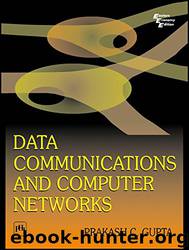Data Communications and Computer Networks by PRAKASH C. GUPTA

Author:PRAKASH C. GUPTA [GUPTA, PRAKASH C.]
Language: eng
Format: epub
Tags: Computers, Networking, General
ISBN: 9788120348646
Google: Zr1nAgAAQBAJ
Amazon: B00TTM1Z54
Publisher: PHI Learning
Published: 2013-11-02T00:00:00+00:00
1 We will describe source routing bridges in Chapter 14.
2 SMT : Station management.
Wireless Local
Area Networks
The local area network types discussed so far in Chapters 11 and 12 use metallic pair (twisted/coaxial pair) or optical fibre as the physical transmission media and are categorized as wired local area networks. In this chapter we introduce another kind of local area network, wireless local area network which is based on wireless transmission medium. The wireless stations can form a local area network of their own or can be adjuncts to a wired local area network. We begin the chapter with configurations and associated definitions of wireless local area networks. Media access control methods, namely Distributed Coordination Function (DCF) and Point Coordination Function (PCF) are described in detail. We examine the layered architecture and IEEE 802.11 MAC frame structure before moving to the physical layer. In the physical layer, we first introduce the various wireless technologies for the physical layer, namely, Direct Sequence Spread Spectrum (DSSS), Frequency Hopping Spread Spectrum (FHSS), infrared wireless local area network, and Orthogonal Frequency Division Multiplexing (OFDM). Thereafter, we move over to the IEEE 802.11 physical layer specifications for these technologies.
13.1 WIRELESS LOCAL AREA NETWORK
In the past few years, there has been growing demand to have networks that permit access by wireless stations so that restriction of physical connectivity of the station to the transmission media is overcome. Wireless local area network as the name suggests is a local area network that uses wireless transmission medium. In addition to the flexibility of mobility of the stations, wireless local area network finds applications where cabling is not feasible or practical, e.g historical buildings, open spaces, etc. Another application of wireless local area network is to connect the local area networks of nearby buildings using a point-to-point wireless link.
Before we go into the technology of wireless local area networks, it is necessary to get familiar with the terminology associated with their configurations and various communication modes. We will use the terminology as defined in IEEE 802.11 standard for wireless local area networks.
13.1.1 Wireless Local Area Network Configuration
Configuration of a wireless local area network is defined in terms of Basic Service Set (BSS), Extended Service Set (ESS), Access Point (AP), and Distribution System (DS).
Basic service set (BSS). A wireless local area network consists of stations that communicate with one another using wireless transmission medium (Figure 13.1). Each station has a wireless network interface for this purpose. The wireless stations are typically battery powered laptops but can be fixed workstation with wireless interface. They share the common wireless transmission medium and compete for access to the medium using the same MAC protocol. A set of such interconnected stations is called basic service set in IEEE 802.11 standard. A BSS, not connected to any other network, is called Independent BSS (IBSS). IBSS is also referred to as ad hoc network.
Download
This site does not store any files on its server. We only index and link to content provided by other sites. Please contact the content providers to delete copyright contents if any and email us, we'll remove relevant links or contents immediately.
Grails in Action by Glen Smith Peter Ledbrook(9163)
Sass and Compass in Action by Wynn Netherland Nathan Weizenbaum Chris Eppstein Brandon Mathis(8808)
Azure Containers Explained by Wesley Haakman & Richard Hooper(7444)
Configuring Windows Server Hybrid Advanced Services Exam Ref AZ-801 by Chris Gill(7433)
Kotlin in Action by Dmitry Jemerov(7263)
Running Windows Containers on AWS by Marcio Morales(6984)
Microsoft 365 Identity and Services Exam Guide MS-100 by Aaron Guilmette(5402)
Microsoft Cybersecurity Architect Exam Ref SC-100 by Dwayne Natwick(5212)
Combating Crime on the Dark Web by Nearchos Nearchou(4982)
The Ruby Workshop by Akshat Paul Peter Philips Dániel Szabó and Cheyne Wallace(4670)
Management Strategies for the Cloud Revolution: How Cloud Computing Is Transforming Business and Why You Can't Afford to Be Left Behind by Charles Babcock(4527)
Python for Security and Networking - Third Edition by José Manuel Ortega(4233)
The Age of Surveillance Capitalism by Shoshana Zuboff(4209)
Learn Wireshark by Lisa Bock(4121)
The Ultimate Docker Container Book by Schenker Gabriel N.;(3888)
Learn Windows PowerShell in a Month of Lunches by Don Jones(3681)
DevSecOps in Practice with VMware Tanzu by Parth Pandit & Robert Hardt(3568)
Windows Ransomware Detection and Protection by Marius Sandbu(3541)
Blockchain Basics by Daniel Drescher(3507)
